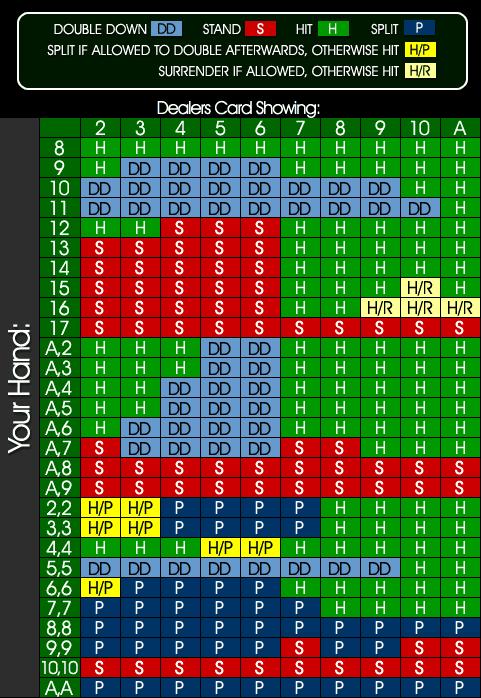Blackjack is certainly the most popular casino attraction because unlike others, it’s very much a game of skill. The goal is to either A) have cards totalling closer to 21 than the dealer’s, or B) force the dealer to go over the sum of 21. Player hands compete only with the dealer’s and other players’ cards and actions have no bearing on play, unless interested in card counting, of course.
Stakes are made in wager circles in front of each chair and the dealer gives each person two cards, beginning from their left. They then give themselves two as well, with only one exposed to the table while the other is face-down for only them to see.
Once action commences players may either “hit”, meaning take another card, or “stand”, meaning take no additional cards. After everyone has made their decisions the dealer then acts on their hand. Unlike players, dealers must play hands according to predetermined rules and in most cases will hit until 17 or more is reached. In some establishments, dealers will also hit on soft 17s (an Ace and a 6).
Basic Blackjack
The entire game of 21 revolves around the value of each card in the deck and it is vital to fully understand the value of each and what it adds to the total count of the hand.
- Ace – Can be either 1 or 11.
- 2-10 – Value as indicated on the card.
- Face Cards (Jacks, Queens and Kings) – All worth 10.
- A card’s suit has no importance.
- A Blackjack is a two-card hand totalling 21, consisting of an Ace and any card with a value of 10.
- A Blackjack beats a multiple-card hand whose value is also 21.
Since an Ace can be used as a value of 1 or 11 so a “soft hand” is one where it can be used as either of these amounts. For example, a player dealt A/5 has the choice of counting this hand as a six or sixteen. A “hard hand” is therefore one where the Ace cannot be used as an 11 and must be used as a 1. As a result, a hand of A/4/9 cannot be 14 or 24 because 24 would bust, so it can only count as 14, thus making it “hard”.
Player Choices
Upon receiving the first two cards, decisions must be made, with all of the possibilities listed below.
Hit: Means taking another card. In a real, live brick and mortar casino, you can point to, or tap the table in order to signal to the dealer you would like another card.
Stand: Means taking no additional cards and sticking with the displayed total. In person you can make a waving gesture toward the dealer in order to signal you don’t want another card.
Split: If dealt a pair of matching cards it’s possible to “split” them into two entirely separate hands. It’s necessary to place an identical wager beside the original to cover the stake and then the dealer will issue additional cards on top of each. In the event another identical card is received, it’s possible to split the hand again (up to a maximum of four separate hands originating from the first, depending on House rules).
Double Down: If the odds are you in your favor it’s optimal to double the original stake and receive one, and only one, card. For example, if the dealer is showing a 5 and your first two cards are a 5 and a 6, a Double Down for one more card is always the correct decision to make.
Insurance: When the dealer’s exposed card is an Ace, players have the option to “buy insurance” against their bottom card having a value of 10, and thus a Blackjack hand (or not). The price of insurance is half the original stake and pays 2-1. A dealer 21 will make players lose their original bets, thus resulting in players effectively breaking even. If they doesn’t have 21 the insurance wager is lost.
Card Counting at Blackjack Tables
Decks loaded with 10’s, face cards and Aces improves player odds while decks filled with small cards gives the advantage to the House. In order to take advantage of these mathematical facts, a player must increase their stake size when odds are in their favor, while risking as little as possible when probabilities have swung the other way.
Here’s a simple explanation of the math: players can choose to stand with a much larger range of hands than dealers, meaning the dealer’s chances of busting are far greater. They must hit until at least soft 17 is reached and hitting hands such as hard 16 is likely to bust in a deck filled with 10’s and face cards. Therefore, this gives players who can count cards an edge over the House by adjusting strategy according to the situation – as long as the pit boss doesn’t figure out what’s going on and throws them out.
As for why a deck filled with Aces and 10s increases the player’s odds of winning, the simple answer is blackjacks pay out at 3:2 odds while it only pays the dealer the exact amount of the stake. This provides a clear advantage to the player.
How do you Count Cards?
It’s not necessary to memorize every card in a 6-deck shoe, as that would be ridiculously difficult to accomplish. Card Counting principles consist of assigning each card a point value that’s used to maintain the deck’s running count. This plus/minus system, often referred to as the High-Lo Card Counting System, assigns cards the following values:
2, 3, 4, 5, 6 = +1
7, 8, 9, = 0
10, J, Q, K, A = -1

Here’s an example of a running count:
First a Jack is dealt and so the running count is at -1. Next is a 3 and so 1 is added, bringing it back to a total of 0. The next card is a 4 adding 1 point so the running count is now at +1. Next is another 4 and so the running count reaches +2, continuing until the end of the shoe and subsequent shuffle.
Balancing the Card Counting Strategy
It’s now necessary to take into account the number of decks in play, so using the previously mentioned example, let’s assume there’s only one. The running count would then be a lot more telling of things to come than say, if there were six decks in play.
To adjust for this factor it’s necessary to determine the true running count, which is actually very simple. The formula is: divide the running count by the number of decks remaining in the shoe, so if there’s a running count of +4 with two decks remaining, the true count would be +2.
Another example: the running count is -9 with 4 decks remaining in the shoe, therefore, the true count would be -2.25. The only tricky part is determining how many decks are left in the shoe, which is done by glancing at the tray of used cards and estimating how many decks this might be. It’s important to be as accurate as possible because the true running count is the basis of any successful card counting strategy.
Blackjack Strategy Guide
This following blackjack strategy guide explains what the best mathematical decision is in every possible scenario at the tables. This is basically a beginner’s bible and should be followed religiously, especially when starting off.
Understanding the chart below is straightforward: look for your hand on the left-most vertical column and then the dealer’s exposed card on the top-most horizontal row. Refer to the legend for acronym meanings. It would also be an excellent idea to print this page and keep it next to your computer for easy reference while practicing.

Basic Blackjack Strategy
- Always stand on 17 or better and always hit on 12 to 16 when the dealer’s exposed card is 7 or higher.
- Always hit on 8 or less.
Double Down Strategy
- Always Double Down on 11, with the exception being when a dealer has an Ace exposed.
- Always Double Down on 10 when the dealer is exposing a 9 or lower.
- Always Double Down on 9 when the dealer is exposing a 6 or lower.
Soft Hands Strategy
- Always stand on soft 19 and soft 20.
- Always Double Down on soft 13 to 18 when the dealer is showing either a 4, 5, or 6.
Split Strategy
- Always split Aces and 8’s.
- Never split 5’s, 10’s or face cards.
- Always split 2’s and 3’s when the dealer is showing a 4, 5, 6, or 7.
